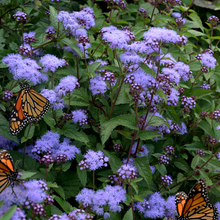Eupatorium Eutrochium 'Coelestinum' is a vigorous and floriferous cultivar of blue mistflower, known for its fluffy clusters of soft lavender blue flowers that bloom late in the season. Its spreading habit and long blooming period make it excellent for naturalizing, and its colorful blossoms are especially striking when contrasted with warm toned fall foliage. It is a reliable bloomer in difficult areas and spreads readily by rhizomes often forming dense colonies over time.
Height & Spread: 18 - 30 in x 24 - 36 in
Bloom Time: Late summer to frost
Light Requirements: Full sun to part shade
Soil Preference: Moist, rich soils preferred; tolerant of average conditions
Watering Needs: Moderate; prefers regular moisture
Deer Resistance: Generally deer resistant
Native Status
This cultivar is derived from the native Conoclinium coelestinum (previously classified as Eupatorium coelestinum), which is widespread in eastern and central North America.
WILDLIFE & INSECTS
Butterflies
- Heavily visited by fall flying species such as Monarchs, Painted Ladies, and Common Buckeyes drawn to its nectar rich blooms.
Bees
- Supports a range of native bees including sweat bees, bumblebees, and long horned bees which are active late in the season.
Moths
- Attracts day flying moths such as the Eight Spotted Forester and various noctuid species seeking late nectar sources.
Birds
- Seed heads may be visited by goldfinches and other small seed eating birds in fall and winter if left standing.
Spacing & Landscape Use
Spacing Recommendations:
- Space 18 - 24 in apart to allow spreading colonies to fill in naturally without overcrowding.
Landscape Placement:
- Effective in rain gardens, naturalized borders, wet meadows, or the back of mixed perennial beds where its loose spreading form provides late season interest and pollinator value.
Companion Plants
- Aster novae-angliae (New England Aster) - Offers tall purple blooms that complement Eupatorium's late season presence and provide nectar for migrating butterflies.
- Solidago rugosa 'Fireworks' (Rough Goldenrod) - Produces arching sprays of golden yellow flowers that contrast with the soft blue blooms of mistflower.
- Vernonia noveboracensis (Ironweed) - Adds bold vertical presence with deep purple flower heads that peak at the same time as Eupatorium.
- Symphyotrichum oblongifolium (Aromatic Aster) - Offers low growing mounds of lavender flowers that extend color into late fall alongside Eupatorium.
- Pycnanthemum muticum (Short Toothed Mountain Mint) - Provides aromatic foliage and late blooming nectar that supports a broad range of pollinators.



